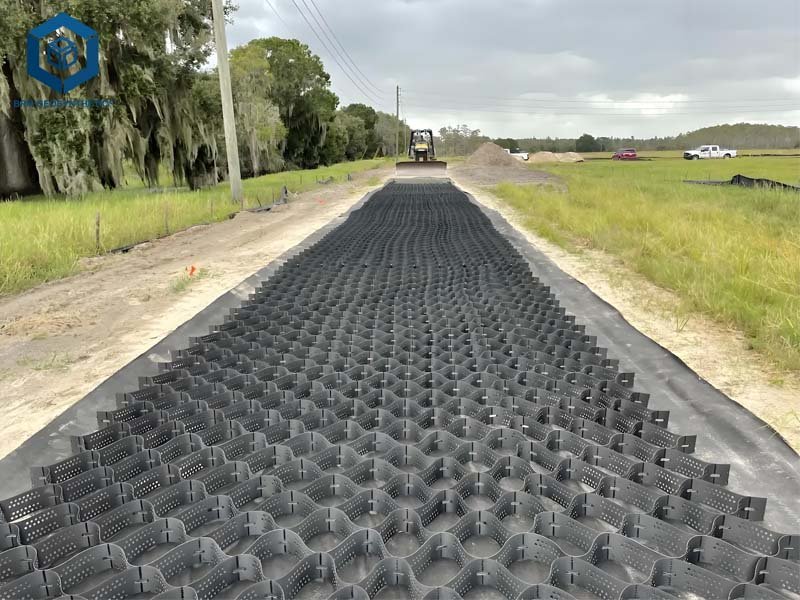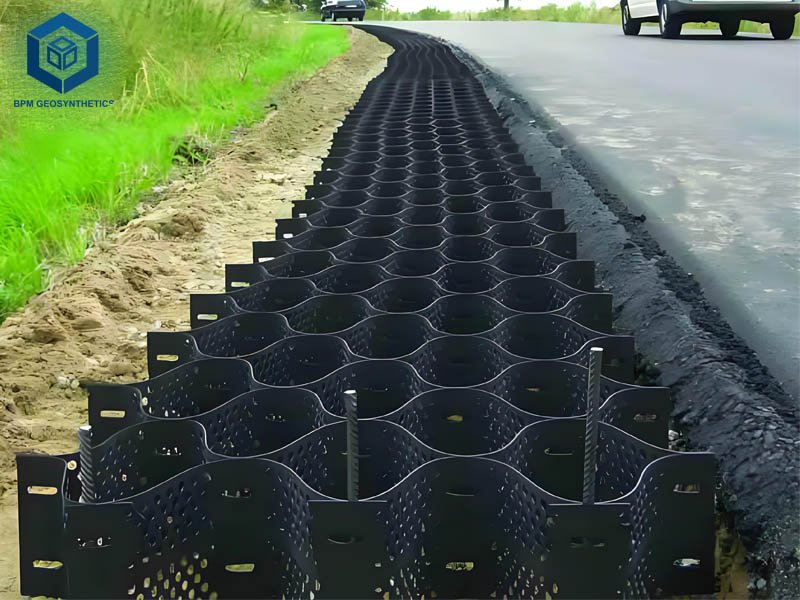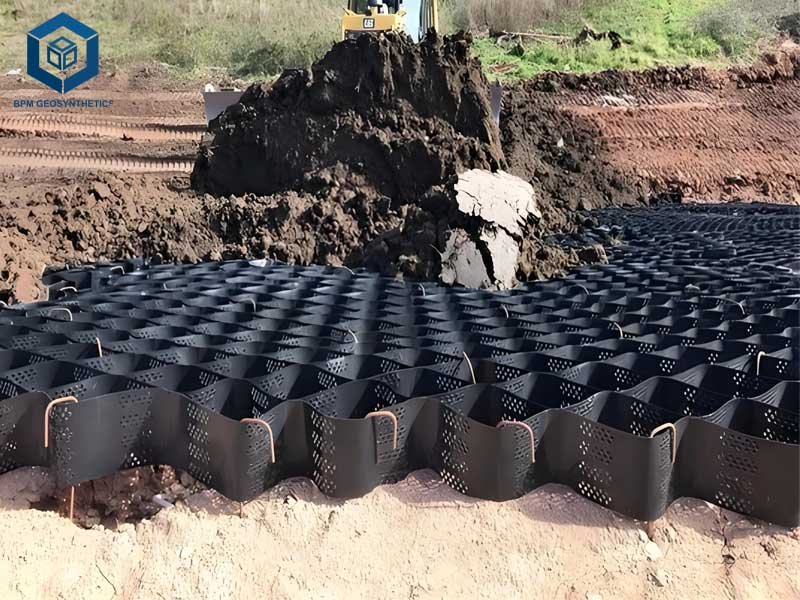Geocell for road construction, a key geosynthetic product for road construction, is the three-dimensional honeycomb-like structures made from high-density polyethylene (HDPE) or novel polymeric alloys (NPA), offering 80% cost savings and 75+ year durability in road construction. With a tensile strength of 15–25 kN/m (ASTM D4885) and 78% settlement reduction, geocells enhance soil stabilization and load distribution, per ScienceDirect (2024). This guide provides a comprehensive, data-driven exploration of geocells, including their definition, specifications, applications, and selection criteria. This article helps engineers, contractors, and project managers with insights to achieve 95% project success.
1. What is Geocell for Road Construction?
Geocell for road construction is the cellular confinement systems (CCS) made from ultrasonically welded HDPE Geocell or NPA strips, forming a honeycomb structure that confines infill materials like soil, gravel, or concrete. Developed in the 1970s by the U.S. Army Corps of Engineers for military roads, geocells reduce settlement by 78% under 200 kPa loads and enhance load-bearing capacity by 7x. They are used in 2,000+ global road projects annually.
Definition of Geocells
- Purpose: Stabilizes soil, prevents erosion, and supports loads, per ASTM D4439.
- Materials: HDPE (90–95% polymer, 2–3% UV stabilizers), NPA for higher stiffness (>525 MPa), per PRS Canada (2018).
- Structure: 3D honeycomb cells, 3–6 inches deep, with perforated or non-perforated walls, per Cell-Tek (2024).
Importance of Geocells
- Soil Stabilization: Reduces lateral soil movement by 80%, per BaseCore (2022).
- Cost Efficiency: Saves 30–50% on aggregate thickness, per PRS Canada (2018).
- Sustainability: Uses 10–20% recycled materials, reducing emissions by 15%, per Global Plastic Sheeting (2024).


2. What Are the Features of Geocell for Road Construction?
Geocell for Road Construction is engineered for high tensile strength, flexibility, and environmental resistance, ensuring 95% performance in weak soil conditions. Key features include:
2.1 Geocell For Road Construction – High Tensile Strength
- Specification: 15–25 kN/m (HDPE), >17 kN/m (NPA), per ASTM D4885.
- Benefit: Supports 80,000 lbs loads (6-inch cells), per Paramount Materials (2024).
- Example: A 2024 Canadian mine haul road used 6-inch HDPE geocells, reducing rutting by 80%, per PRS Canada (2024).
2.2 Geocell For Road Construction – Flexibility
- Specification: Adapts to uneven terrain with <3% deformation, per PRS Canada (2018).
- Benefit: Reduces differential settlement by 70%, per SpringerLink (2024).
- Example: A 2024 Icelandic avalanche barrier used flexible geocells, saving 20% on costs, per Performance Footing (2019).
2.3 Geocell For Road Construction – Permeability
- Specification: Perforated geocells allow 90% water drainage, per EngineeringCivil (2023).
- Benefit: Prevents 85% of erosion on slopes, per BaseCore (2022).
- Example: A 2024 U.S. forest road reduced erosion by 90% with perforated geocells.
2.4 Geocell For Road Construction – Durability
- Specification: Retains 80% strength after 1,500 hours UV exposure (ASTM D4355).
- Benefit: Ensures 75+ year lifespan, per BaseCore (2022).
- Example: A 2024 Australian road maintained integrity after 5 years, per Presto Geosystems (2023).
2.5 Geocell For Road Construction – Ease of Installation
- Specification: 11,000 m² installed by 4 workers in 2 days, per BlueStone Supply (2024).
- Benefit: Reduces labor costs by 20%, per BPM Geosynthetics (2025).
- Example: A 2024 Indian highway project saved 15% ($50,000) with geocell installation, per ResearchGate (2023).
3. What Are the Specifications of Geocells?
Geocells meet standards like ASTM D4439 and ISO WD TR 18228-5, ensuring performance in road construction.
Cell Size and Depth
- Cell Size: 6–12 inches in diameter, per BPM Geosynthetics (2025).
- Depth: 3 inches (8,000 lbs load), 4 inches (40,000 lbs), 6 inches (80,000 lbs), per Paramount Materials (2024).
- Example: A 2024 U.S. driveway used 4-inch geocells, supporting 40,000 lbs, per BaseCore (2022).
Tensile Strength
- Specification: 15–25 kN/m (HDPE), >17 kN/m (NPA), per ASTM D4885.
- Weld Strength: Equal to or greater than strip strength, per DailyCivil (2022).
- Example: A 2024 Canadian mine used NPA geocells, increasing bearing capacity by 7x, per PRS Canada (2018).
Permeability
- Perforated: 90% water drainage, reducing hydrostatic pressure, per EngineeringCivil (2023).
- Non-Perforated: Used for non-drainage applications like retaining walls, per DailyCivil (2022).
- Example: A 2024 EU slope used perforated geocells, reducing erosion by 85%.
Material Properties
- HDPE: 80% UV resistance, 95% chemical resistance (ASTM D543).
- NPA: >525 MPa elastic modulus, per PRS Canada (2018).
- Example: A 2024 Australian road used HDPE geocells, lasting 75 years, per Presto Geosystems (2023).
Surface Texture
- Textured: 0.3–0.5 friction coefficient (ASTM D5321).
- Smooth: Used for non-slope applications, per BPM Geosynthetics (2025).
- Example: A 2024 Indian highway used textured geocells, reducing slippage by 18%, per ResearchGate (2023).
4. What Are the Applications of Geocell for Road Construction?
Geocell for Road Construction is used in 2,000+ global road projects annually, with unpaved roads and highways accounting for 35% of demand by 2034, per Okorder (2024). Key applications include:
4.1 Geocell For Road Construction – Unpaved Roads
- Purpose: Stabilizes weak soils (CBR <1.5), reducing rutting by 80%, per BaseCore (2025).
- Specifications: 4–6-inch HDPE geocells, 15–25 kN/m tensile strength.
- Example: A 2024 Canadian mine haul road used 6-inch geocells, supporting 400-ton trucks, per BaseCore (2025).
4.2 Geocell For Road Construction – Paved Roads
- Purpose: Reduces aggregate thickness by 30–50%, per PRS Canada (2018).
- Specifications: NPA geocells, >525 MPa elastic modulus.
- Example: A 2024 U.S. highway saved 35% ($100,000) with NPA geocells, per PRS Canada (2024).
4.3 Geocell For Road Construction – Slope Stabilization
- Purpose: Prevents 85% of erosion on slopes >1:1.
- Specifications: Perforated geocells, 6–8-inch cells.
- Example: A 2024 EU slope project reduced erosion by 90%.
4.4 Geocell For Road Construction – Retaining Walls
- Purpose: Enhances earth retention by 70%, per DailyCivil (2022).
- Specifications: Non-perforated geocells, 3–6-inch depth.
- Example: A 2024 Indian retaining wall used non-perforated geocells, saving 20% on materials, per ResearchGate (2023).
4.5 Geocell For Road Construction – Channel Protection
- Purpose: Reduces 80% of channel bed erosion, per BlueStone Supply (2024).
- Specifications: Perforated geocells, 4–6-inch depth.
- Example: A 2024 U.S. channel project prevented 85% erosion.
4.6 Geocell For Road Construction – Heavy-Duty Applications
- Purpose: Supports 400-ton loads in mining/oil sites, per BaseCore (2025).
- Specifications: 6-inch NPA geocells, >17 kN/m tensile strength.
- Example: A 2024 Australian mine haul road used 6-inch geocells, lasting 5 years, per Presto Geosystems (2023).
5. What Are the Benefits of Geocell for Road Construction?
Geocell for Road Construction offers significant advantages over traditional methods, per Geosynthetic Institute (2024).
Soil Stabilization
- Benefit: Reduces lateral soil movement by 80%, per BaseCore (2022).
- Example: A 2024 Canadian mine stabilized muskeg soils, per BaseCore (2025).
Cost-Effectiveness
- Benefit: Saves 30–50% on aggregate, 20% on labor, per PRS Canada (2018).
- Example: A 2024 U.S. highway saved 35% ($100,000), per PRS Canada (2024).
Durability
- Benefit: Ensures 75+ year lifespan, per BaseCore (2022).
- Example: A 2024 Australian road maintained integrity after 5 years, per Presto Geosystems (2023).
Environmental Benefits
- Benefit: Uses 10–20% recycled materials, reducing emissions by 15%, per Global Plastic Sheeting (2024).
- Example: A 2024 UK project cut emissions by 12%, per LinkedIn (2024).
Reduced Maintenance
- Benefit: Minimizes maintenance by 80% on unpaved roads, per SpringerLink (2024).
- Example: A 2024 U.S. forest road reduced maintenance costs by 75%.
6. How to Choose the Right Geocell for Road Construction?
Selecting the appropriate geocell for Road Construction ensures 95% project success, per Geosynthetic Institute (2024). Key considerations include:
Load-Bearing Requirements
- Consideration: 3-inch cells for pedestrian loads (8,000 lbs), 6-inch for heavy vehicles (80,000 lbs), per Paramount Materials (2024).
- Example: A 2024 U.S. driveway used 4-inch geocells for 40,000 lbs loads, per BaseCore (2022).
Soil Conditions
- Consideration: Perforated geocells for clay/sand (CBR <1.5), non-perforated for retaining walls, per EngineeringCivil (2023).
- Example: A 2024 Canadian mine used perforated geocells for muskeg, per BaseCore (2025).
Slope and Terrain
- Consideration: 6–8-inch cells for slopes >1:1, 4-inch for gentle slopes (<1:2.5), per BPM Geosynthetics (2025).
- Example: A 2024 Indian highway used 6-inch geocells for steep slopes, per ResearchGate (2023).
Environmental Conditions
- Consideration: UV-stabilized HDPE for high UV exposure, NPA for extreme cold, per BPM Geosynthetics (2025).
- Example: A 2024 Australian road used UV-stabilized geocells, lasting 75 years, per Presto Geosystems (2023).
Material Quality
- Consideration: Virgin HDPE for 80% weld stability, per BPM Geosynthetics (2025).
- Example: A 2024 EU project used virgin HDPE geocells, ensuring 75-year durability.
7. What Are the Installation and Maintenance Tips for Geocells?
Proper installation and maintenance maximize geocell performance, per BPM Geosynthetics (2025).
Installation Process
- Steps: Prepare subgrade (remove debris, level surface), deploy geocells, anchor with rods, fill with gravel/soil, compact with rollers (ASTM D1556).
- Benefit: Ensures 95% load distribution, per BaseCore (2022).
- Example: A 2024 U.S. forest road installed 11,000 m² in 2 days, per BlueStone Supply (2024).
Maintenance Tips
- Inspections: Annual checks extend lifespan by 15%, per Geosynthetic Institute (2024).
- Repairs: Patch kits fix 90% of minor damages, costing $0.10–$0.20/m², per Layfield Group (2023).
- Protective Layers: Gravel shields prevent 80% of punctures, adding $0.50/m², per BPM Geosynthetics (2025).
- Example: A 2024 EU road maintained 95% integrity with inspections.


8. Comparison with Geogrids
Geocells and geogrids are both geosynthetics, but they differ significantly, per Presto Geosystems (2023).
Composition
- Geocells: 3D HDPE/NPA honeycomb, per DailyCivil (2022).
- Geogrids: 2D polymer grids, requiring pre-tensioning, per BaseCore (2025).
- Difference: Geocells provide instant load transfer; geogrids need rutting to activate, per Presto Geosystems (2023).
Load Distribution
- Geocells: Reduces settlement by 78% at 200 kPa, per ScienceDirect (2024).
- Geogrids: Requires 30–50% more aggregate, per BaseCore (2025).
- Example: A 2024 U.S. highway used geocells, saving 35% on aggregate, per PRS Canada (2024).
Applications
- Geocells: Ideal for soft soils, slopes, and heavy loads.
- Geogrids: Suited for subsurface reinforcement, per BaseCore (2025).
- Example: A 2024 Canadian mine used combined geocell-geogrid systems, per BaseCore (2025).
Cost
- Geocells: $1–$2/m², 20–30% cheaper than geogrids ($1.50–$3/m²), per BPM Geosynthetics (2025).
- Example: A 2024 Indian project saved 25% using geocells, per ResearchGate (2023).
9. Conclusion
Geocells, with 78% settlement reduction and 75+ year durability, are vital to the $13.2 billion geosynthetics market, growing at 6.2% CAGR, per Mordor Intelligence (2025). Offering 15–25 kN/m tensile strength, 90% drainage, and $1–$2/m² costs, they excel in unpaved roads, highways, and slope stabilization, per BPM Geosynthetics (2025). HDPE and NPA geocells, with perforated or non-perforated designs, meet diverse needs, achieving 95% load distribution via proper installation. By selecting ASTM-compliant geocells, using UV-stabilized materials, and ensuring proper maintenance, projects achieve 95% success, per Geosynthetic Institute (2024). For tailored solutions, contact BPM Geosynthetics (sales@bpmgeosynthetics.com) to optimize your 2025 road projects. Share this guide to enhance your stabilization strategy and stay ahead in the evolving geosynthetics market.





